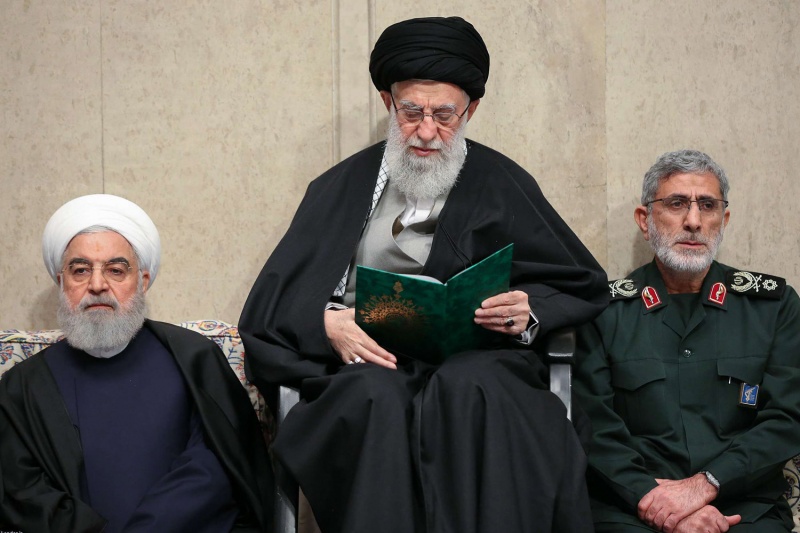Iran’s line of succession in doubt amid Khamenei concerns
Dr. Majid Rafizadeh/Arab News/January 18/2021
د. مجيد رافيزادا: سلم تسلسل الخلافة الإيرانية محل شك وسط مخاوف خامنئي
In summary, if Supreme Leader Khamenei dies, either the nation will rise up against the regime and threaten its hold on power or the IRGC will manage to hand-pick a sycophant who would act as its puppet, granting it free rein in political and economic affairs, increasing its leverage over Iran’s other institutions.
*********************
There have been many rumors and reports about Iranian Supreme Leader Ali Khamenei’s deteriorating health for several years. This raises an important question: What will happen when Khamenei, supreme leader for almost 32 years, dies?
Experts, scholars, policy analysts and some politicians may jump into naming candidates who could replace him. But Khamenei’s death might lead to a nationwide uprising against the theocratic establishment, endangering its hold on power.
Since millions of people will be allowed to attend his funeral, this could provide the perfect platform for an overwhelming majority of the population to demonstrate against the authorities.
Many in Iran believe that the paramount leader, who enjoys the final say on all Iran’s domestic and foreign policies, is the glue that holds the Islamic Republic together. His death could empower the population to rise up against the system. After all, disaffectedness toward the government and officials has reached an unprecedented level in the last few years.
Another possible scenario is that Khamenei might step down if his health status becomes critical. This way, there could be a monitored transition of power and the regime would eliminate the danger of being overthrown.
According to Iran’s constitution, several political bodies will play a role in deciding who will succeed Khamenei. However, the reality is that one particular organization — the Islamic Revolutionary Guard Corps (IRGC), which does not have constitutional authority in this matter — will probably be the final decision-maker.
Over the past two decades, the IRGC has grown to be the country’s political and economic powerhouse.
Then the question becomes: Who does the senior cadre of the IRGC want to be the next supreme leader? The most important criterion for the IRGC elite is that they want an individual they can control, not vice versa. It follows that they would prefer a low-profile cleric who totally supports the IRGC’s activities, its political and economic monopoly, and its objectives, such as advancing Iran’s nuclear program and promoting the regime’s regional hegemonic ambitions.
The last thing the IRGC wants is a supreme leader who would challenge their authority and power. Therefore, anyone who is considered a moderate or a reformist is not a serious candidate.
The supreme leader’s death could empower the population to rise up against the system.
People such as Ebrahim Raisi and Mojtaba Khamenei (the supreme leader’s second son) could be good candidates for the IRGC, as long as they keep a low profile, do not attempt to project their power and influence on the IRGC, and do not challenge the rule and autonomy of the IRGC leaders, the Guardian Council and the Expediency Council.
When Khamenei replaced the founder of the Islamic Republic Ayatollah Khomeini in 1989, he was among the least-qualified candidates, particularly when compared to influential people such as Hussein-Ali Montazeri. Montazeri, who was at one time the designated successor to Khomeini, was removed as the next in line because he challenged the authorities.
Khamenei’s divine authority, legitimacy and credibility were heavily questioned by the high-level clerics in the city of Qom. He was not even a Marja’ or Mujtahid, capable of issuing fatwa, which is a requirement of the constitution. He was also considered a weak supreme leader and lacking in charisma when compared to Khomeini. Because Iran’s constitution emphasizes the religious authority and qualifications of a supreme leader, Khamenei’s appointment was undoubtedly a political move rather than a religious one.
Although Khamenei was weak at the beginning, he was unexpectedly successful and managed to marginalize the high-level clerics who opposed him, creating his own inner circle and foreign policy office, while making a robust alliance with the IRGC in order to control the opposition.
As time passed, his views also altered, and he became more in favor of Iran’s nuclear weapons program, as well as more anti-American. In other words, he created a political structure that is a combination of military dictatorship and theocracy.
Finally, there is a theory that the position of supreme leader might be abolished altogether if Khamenei dies. However, the foundational basis of the Islamic Republic and its interpretation of Shiite Islam are anchored in the concept of Velayat-e Faqih (Guardianship of the Islamic Jurist), which was advanced by Khomeini. As a result, such a scenario is extremely unlikely.
In summary, if Supreme Leader Khamenei dies, either the nation will rise up against the regime and threaten its hold on power or the IRGC will manage to hand-pick a sycophant who would act as its puppet, granting it free rein in political and economic affairs, increasing its leverage over Iran’s other institutions.
*Dr. Majid Rafizadeh is a Harvard-educated Iranian-American political scientist. Twitter: @Dr_Rafizadeh





















